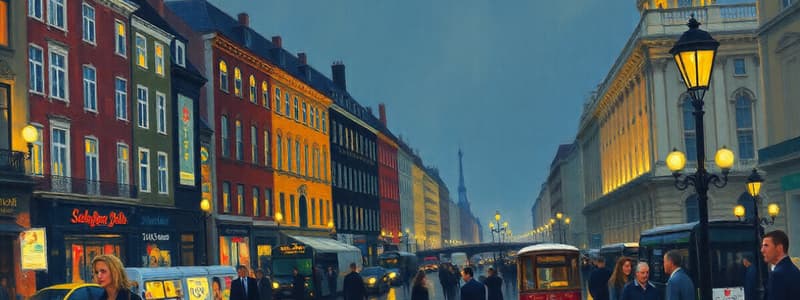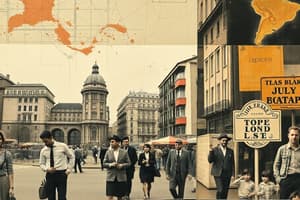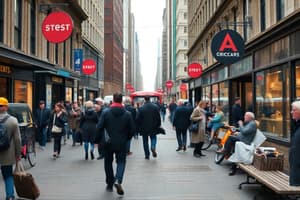Podcast
Questions and Answers
Which of these is NOT a characteristic that Simmel faced because of his Jewish ancestry and intellectual radicalism?
Which of these is NOT a characteristic that Simmel faced because of his Jewish ancestry and intellectual radicalism?
- Recurring lectureship at University of Berlin
- A limited network in the intellectual scene (correct)
- Marginalization by the German academic system
- Lack of a regular academic appointment until late in his career
Based on the information provided, which of these is NOT a defining factor of Georg Simmel's life?
Based on the information provided, which of these is NOT a defining factor of Georg Simmel's life?
- He was a public intellectual
- He was a resident of Weimar, Germany
- He was a non-observant Jew
- He was a proponent of a specific political ideology (correct)
What is the best comparison between Simmel's environment in Berlin and the cities mentioned in the text?
What is the best comparison between Simmel's environment in Berlin and the cities mentioned in the text?
- Simmel's environment is similar to a modern city's bustling commercial and theatrical district (correct)
- Simmel's environment lacks the cultural significance found in the other cities mentioned
- Simmel's environment was vastly more culturally prominent than the cities mentioned.
- Simmel's environment is significantly different from the cities mentioned as they are not in Germany
What does the text imply about Georg Simmel's intellectual legacy?
What does the text imply about Georg Simmel's intellectual legacy?
The text describes Georg Simmel as a 'rootless Cosmopolitan'. What does this term imply about Simmel?
The text describes Georg Simmel as a 'rootless Cosmopolitan'. What does this term imply about Simmel?
Which of these is NOT mentioned in the text as a reason for Simmel's academic marginality?
Which of these is NOT mentioned in the text as a reason for Simmel's academic marginality?
Based on the information provided, what was Simmel's main area of study?
Based on the information provided, what was Simmel's main area of study?
Which of these statements best reflects Simmel's position within the German intellectual landscape?
Which of these statements best reflects Simmel's position within the German intellectual landscape?
What is necessary to find a source of income that is not yet exhausted?
What is necessary to find a source of income that is not yet exhausted?
What does specialization promote according to the content?
What does specialization promote according to the content?
How does the individual follow the growth of spirit according to the content?
How does the individual follow the growth of spirit according to the content?
What comparison reveals a frightful disproportion in growth?
What comparison reveals a frightful disproportion in growth?
What does the content suggest about the public's needs?
What does the content suggest about the public's needs?
What is indicated as a significant factor influencing personality assertion?
What is indicated as a significant factor influencing personality assertion?
What does the term 'immense culture' refer to in the content?
What does the term 'immense culture' refer to in the content?
Which of the following best describes the relationship between the individual and public cultural growth?
Which of the following best describes the relationship between the individual and public cultural growth?
What leads to the retrogression in individual culture regarding spirituality and idealism?
What leads to the retrogression in individual culture regarding spirituality and idealism?
What is the impact of one-sided accomplishments according to the content?
What is the impact of one-sided accomplishments according to the content?
What is a consequence of individuals focusing on extravagant behaviors?
What is a consequence of individuals focusing on extravagant behaviors?
Why do individuals in metropolitan settings feel the need to adopt capricious behaviors?
Why do individuals in metropolitan settings feel the need to adopt capricious behaviors?
What do quantitative increases in urban life often sacrifice?
What do quantitative increases in urban life often sacrifice?
What does the term 'objective culture' refer to in this context?
What does the term 'objective culture' refer to in this context?
What type of accomplishments does the division of labor push individuals towards?
What type of accomplishments does the division of labor push individuals towards?
What do the peculiarities such as mannerism and caprice signify in metropolitan life?
What do the peculiarities such as mannerism and caprice signify in metropolitan life?
What does the passage suggest about the urban modernist's experience?
What does the passage suggest about the urban modernist's experience?
What is a central idea expressed in Simmel’s essay “The Stranger” ?
What is a central idea expressed in Simmel’s essay “The Stranger” ?
According to Simmel, what is the significance of the “stranger” in society?
According to Simmel, what is the significance of the “stranger” in society?
How does Simmel's perspective on the “stranger” relate to social deviance?
How does Simmel's perspective on the “stranger” relate to social deviance?
What is the author’s interpretation of Simmel’s interest in “micro-sociological realms”?
What is the author’s interpretation of Simmel’s interest in “micro-sociological realms”?
How does Simmel’s wandering Jewish trader exemplify his concept of the “stranger”?
How does Simmel’s wandering Jewish trader exemplify his concept of the “stranger”?
What is the connection between the passage's discussion of Simmel's work and the “cultural turn” in sociology?
What is the connection between the passage's discussion of Simmel's work and the “cultural turn” in sociology?
What is a key takeaway from the passage's analysis of Simmel's work?
What is a key takeaway from the passage's analysis of Simmel's work?
What is the primary source of the blasé attitude in the context of metropolitan life?
What is the primary source of the blasé attitude in the context of metropolitan life?
How does the blasé attitude manifest in metropolitan children?
How does the blasé attitude manifest in metropolitan children?
What does the text suggest is the consequence of the blasé attitude on the individual?
What does the text suggest is the consequence of the blasé attitude on the individual?
What is the underlying reason for the blasé attitude according to the text?
What is the underlying reason for the blasé attitude according to the text?
How does the text describe the way things are perceived by someone with a blasé attitude?
How does the text describe the way things are perceived by someone with a blasé attitude?
What is the primary difference between the blasé attitude and the perception of a half-wit?
What is the primary difference between the blasé attitude and the perception of a half-wit?
What is the primary reason why an individual with a blasé attitude might exhibit negative social behavior?
What is the primary reason why an individual with a blasé attitude might exhibit negative social behavior?
How does the blasé attitude relate to the individual’s self-preservation in the face of the city?
How does the blasé attitude relate to the individual’s self-preservation in the face of the city?
What is the hallmark of the modern city of commerce?
What is the hallmark of the modern city of commerce?
What is the connection between the "flaneur" and the urban cosmopolitan?
What is the connection between the "flaneur" and the urban cosmopolitan?
Which of the following is NOT mentioned in the text as a characteristic of the modern urban individual?
Which of the following is NOT mentioned in the text as a characteristic of the modern urban individual?
How does the text portray the impact of commerce on modern urban life?
How does the text portray the impact of commerce on modern urban life?
What is the main point of the text's reference to Marx's adage, “all that is solid melts into air”?
What is the main point of the text's reference to Marx's adage, “all that is solid melts into air”?
Which of the following BEST reflects the text's view of the bourgeois urbanist?
Which of the following BEST reflects the text's view of the bourgeois urbanist?
The text uses the phrase "monkish self-reflection" to describe a characteristic of the modern urban individual. Which of the following is the MOST LIKELY reason for this?
The text uses the phrase "monkish self-reflection" to describe a characteristic of the modern urban individual. Which of the following is the MOST LIKELY reason for this?
What is the main theme of the text?
What is the main theme of the text?
Flashcards
Mental Life in the Metropolis
Mental Life in the Metropolis
The intense social stimulation and rapid changes of urban life.
Nervous Stimulation
Nervous Stimulation
The constant bombardment of sensory information and social interactions in urban environments.
The Blasé Attitude
The Blasé Attitude
A mental attitude or strategy used to cope with the overstimulation of city life. It involves developing a blasé attitude and a sense of detachment from others.
Social Distance
Social Distance
Signup and view all the flashcards
Loss of Individuality
Loss of Individuality
Signup and view all the flashcards
Social Differentiation
Social Differentiation
Signup and view all the flashcards
Role Differentiation
Role Differentiation
Signup and view all the flashcards
Social Networks
Social Networks
Signup and view all the flashcards
Melting of the Solid into Air
Melting of the Solid into Air
Signup and view all the flashcards
Urban Cosmopolitan
Urban Cosmopolitan
Signup and view all the flashcards
Flaneur
Flaneur
Signup and view all the flashcards
Loneliness of Life in the Crowd
Loneliness of Life in the Crowd
Signup and view all the flashcards
Pedestrian Dandy
Pedestrian Dandy
Signup and view all the flashcards
Monkish Self-Reflection
Monkish Self-Reflection
Signup and view all the flashcards
Restlessness of Liberation
Restlessness of Liberation
Signup and view all the flashcards
Inner Emotional Development
Inner Emotional Development
Signup and view all the flashcards
Urban Modernist's Dilemma
Urban Modernist's Dilemma
Signup and view all the flashcards
The Stranger
The Stranger
Signup and view all the flashcards
Social Type or Category
Social Type or Category
Signup and view all the flashcards
Spatial Rules and Social Etiquette
Spatial Rules and Social Etiquette
Signup and view all the flashcards
Differentiation of the 'Other'
Differentiation of the 'Other'
Signup and view all the flashcards
Micro-Sociological Realms
Micro-Sociological Realms
Signup and view all the flashcards
Cultural Turn in Sociology
Cultural Turn in Sociology
Signup and view all the flashcards
David Frisby
David Frisby
Signup and view all the flashcards
Individualization
Individualization
Signup and view all the flashcards
Specialization
Specialization
Signup and view all the flashcards
Public Spirit
Public Spirit
Signup and view all the flashcards
Cultural Gap
Cultural Gap
Signup and view all the flashcards
Mental and Psychic Traits
Mental and Psychic Traits
Signup and view all the flashcards
Individualization in the City
Individualization in the City
Signup and view all the flashcards
Enrichment of Public Needs
Enrichment of Public Needs
Signup and view all the flashcards
Immense Culture
Immense Culture
Signup and view all the flashcards
Metropolitan Blasé Attitude
Metropolitan Blasé Attitude
Signup and view all the flashcards
Nerve Energy
Nerve Energy
Signup and view all the flashcards
Blunting of Discrimination
Blunting of Discrimination
Signup and view all the flashcards
Self-Preservation in the City
Self-Preservation in the City
Signup and view all the flashcards
Devaluation of the Objective World
Devaluation of the Objective World
Signup and view all the flashcards
Social Nature of Blasé Attitude
Social Nature of Blasé Attitude
Signup and view all the flashcards
Money Economy's Influence
Money Economy's Influence
Signup and view all the flashcards
Coming to Terms with City Life
Coming to Terms with City Life
Signup and view all the flashcards
Blasé Attitude
Blasé Attitude
Signup and view all the flashcards
One-Sided Accomplishment
One-Sided Accomplishment
Signup and view all the flashcards
Overgrowth of Objective Culture
Overgrowth of Objective Culture
Signup and view all the flashcards
Qualitative Differentiation
Qualitative Differentiation
Signup and view all the flashcards
Individual as Negligible Quantity
Individual as Negligible Quantity
Signup and view all the flashcards
Retrogression in Culture
Retrogression in Culture
Signup and view all the flashcards
Growing Division of Labor
Growing Division of Labor
Signup and view all the flashcards
Study Notes
Georg Simmel's "The Metropolis and Mental Life"
- Simmel, born in 1858, was a Jewish philosopher and sociologist.
- He was born in Berlin, a commercial and theatrical center.
- Simmel was marginalized by the German academic system due to his Jewish ancestry and intellectual radicalism.
- He was an influential lecturer at the University of Berlin, despite being an academic outsider.
- He was a public intellectual, and associated with prominent figures like Max Weber and Rainer Maria Rilke.
- Simmel's essay "Die Großstädte und das Geistesleben" (cited as "The Metropolis and Mental Life") was delivered in 1902-03.
- The lecture series was connected to an exhibition on the emerging modern metropolis in Dresden.
- The exhibition, part of a larger trend in world-city expositions, focused on the intellectual, economic, and political dimensions of German urbanism.
- Simmel focused on the philosophical and psychological implications of urban transitions, and the social construction of the modern urban self.
- He viewed the metropolis as a nexus of capital, commodities, and people.
- Simmel's work explored the rise of objectification and quantification in the money economy and its impact on modern culture.
- Simmel's perspectives on the city align with Marx's observations about the dissolving effects of modern capitalism's logic.
- His concept of the "flaneur" resonates with figures like Benjamin and Baudelaire.
Key Themes in the Essay
- Intensification of Nervous Stimulation: The rapid and constant change of stimuli in the metropolis leads to a heightened nervous awareness and a different kind of consciousness.
- Differentiation of Consciousness: The metropolis requires the intellect to adapt to rapid changes, which distinguishes it from the slower-paced small towns.
- Rise of Objectification and Quantification in the Metropolis: In the face of the huge impersonal forces of the city, the individual's personality begins to disappear or seem inessential; personal relations are reduced to transactions and cold calculations.
- Impersonality and Calculated Interactions: The large-scale interaction of the city necessitates an impersonal social machinery and measured, calculable interactions.
- The Metropolis as a Center of the Money Economy: The metropolis, being the center of economic exchange, emphasizes exchange value over intrinsic value.
- The Blasé Attitude: This is a form of emotional detachment in response to the overwhelming stimuli of the city.
- Reserve as a Social Mechanism: To maintain a sense of self against impersonal metropolitan interactions, people adopt a stance of reserve.
- Individuality and Freedom in the Metropolis: While the city can be impersonal, it also allows for a unique form of personal freedom.
- The Pressure of the Objective Spirit: The metropolis fosters a "general human character"; the individual faces a choice between participation in the objective, larger structures of modern life, and a loss of unique personal characteristics.
Studying That Suits You
Use AI to generate personalized quizzes and flashcards to suit your learning preferences.




